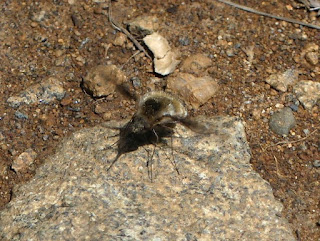Large Bee-fly?
Here's someone I met that I think I know, the Large Bee-fly. Despite the name, I wouldn't consider them to be large; they're measured in millimeters (6-12 mm). Presumably in the world of the bee flies they're relatively large, but no one who's not an entomologist is likely to say "Wow - look at the size of that thing!".
I have to admit that I wasn't able to get any confirmation of the identification from iNaturalist, but the photos on Wikipedia look pretty close. And the Large Bee-fly is considered to be pretty common; it's not a stretch to imagine them at Sourland.
When I took the pictures I saw them either on flowers or sunning themselves out in the open, and I suspected they might be flower flies (aka hover flies) of some sort. This would have given them an ecological niche very similar to many of our bees, competing with bees for nectar/pollen and important pollinators in their own right.
Fortunately iNaturalist's picture recognition algorithm suggested something very different, a greater bee fly of some sort. Until flower flies, the bee flies have a more nefarious relationship with bees. Although they do some pollination as adults, in their larva stage they're bee parasites. The adult females find the nests of burrowing bees and flick their eggs into the burrows. The larva that hatch from the eggs will go on to feed on the food stores that the bee left for its grubs, and then the fly larva goes on to eat the bee grubs themselves. Eventually (the next spring) the bee flies will emerge from the burrows as adults, repeating the whole process.
 |
| May 6, 2021 at Sourland Mountain Preserve Photo 128957808, (c) jpviolette, some rights reserved (CC BY-NC) |



Comments
Post a Comment